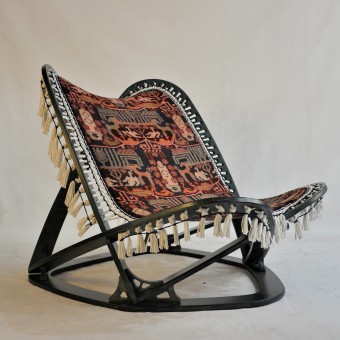Khayyam Lounge Chair by Fater Saadat Niaki |
Home > Winners > #91775 |
 |
|
||||
| DESIGN DETAILS | |||||
| DESIGN NAME: Khayyam PRIMARY FUNCTION: Lounge Chair INSPIRATION: The frame design is essentially deconstruction and reconstruction of a famous Iranian architects work: Hooshang Seyhoun, for the mausoleum of Omar Khayyam;The medieval Persian mathematician, astronomer and poet. Seyhoun used quadratic arches with a ten degree tilt from perpendicular angle and repeated it ten times around an axis, thus creating an intricate structure of crisscrossing arches had been created. Similarly the same replication of quadratic arcs has been envisaged with Khayyam's quartains in mind as the source of inspiration. Each two pairs are angled to create seating and backrest structure while still being interconnected. "Khayyam" literally means tent maker, which was the profession of his forefathers. This is hinted by tent like shape created by crossing structures and echoed by the very fact that the seating surface is attached essentially using tent fabric fixing methods. Other elements of Iranian architecture has found their ways in various parts of the structure as reinforcement, although in simplified format namely the shape of the gussets are using design cues of a structural element called Muqarnass which divide the force and the weight of an arch between two pillars or adjacent Moqarnass. UNIQUE PROPERTIES / PROJECT DESCRIPTION: For many centuries, carpets and rugs has been used as floor insulator that keeps the ambient temperature of a room regulated by not allowing any heat transfer to the ground and vice versa, while serving as a secondary function of decorative element. But, in modern times, the utilitarian functionality of a carpet has lost its stance to more modern building materials and insulation, making it only a decorative item. The inherent handmade fabrication method makes carpet weaving extremely labor-intensive and daunting to such extent that makes it economically unavailable for middle-class households. This and the very change of the tastes, made carpet weaving struggling as a handcraft industry in Iran. While not more than fifty years ago nearly every other household in rural communities had a carpet weaving loom that plays the essential role in community's economy and self-sufficiency, there are dwindling number of centers still active in this business nowadays. This project is willing to revive the value of this handcraft industry and makes it find its new stance; not perhaps only for decorative purposes, but the one that serves a real function; and that is achieved by unique weight bearing property of carpet that is rediscovered and elaborated in this design. Rugs still are considered soft goods, but just like a hammock can withstand the weight of an adult 95 percentile very easily if chosen properly. Specifically the carpets woven with two threads in each row, like Sarab, Tabriz, Hamadan, Zanjan, etc., are more suitable and stronger for this purpose. OPERATION / FLOW / INTERACTION: The product comes with an already attached carpet fitted in a square box, once unpacked the four arches are interlocked to each other on specified mortise and tenon and edge half-lap joint and reinforce with right angled gussets that are fastened with socket screws and insert nuts. The half assembled frame is turned upside down and the base ring and accompanying wedge gussets are inserted in specified grooves and secured with long countersunk socket screws that are fastened to the wood insert nuts. PROJECT DURATION AND LOCATION: The project started in June 2017 in Tehran and finalized in November 2017 after a number of iterations. Three series of nuts have been tested on various types of rugs to choose the best combination for frame attachment. Technique with a strongest final result to be chosen. FITS BEST INTO CATEGORY: Furniture Design |
PRODUCTION / REALIZATION TECHNOLOGY: The frame is cut by a CNC router from a 1220*2440 mm international standard 18 mm baltic birch plywood. Various digital joinery techniques including mortise and tenon, half-lap joint and screw and insert nut fasteners is used to create glue free structure that could be easily stored. The seating surface is made by reused carpets, hand-woven rugs, that are cut with an specific template, stitched and woven to the frame. SPECIFICATIONS / TECHNICAL PROPERTIES: Assembled Product Dimensions: width: 820mm × depth: 1020mm × height: 830mm flat packed in box: width 1140mm X length 1140mm X height 120mm TAGS: birch plywood, upcycling, hand-woven rug, flat-pack design, DIY assembly RESEARCH ABSTRACT: As the main challenge for this design was to determine how strong the Carpet fabric should be to withstand the dynamic loading of the 95th percentile users, an extensive search among the strongest known designs from all corners of the Iranian carpet weaving centers has been conducted and since one of the team members has a family heritage of carpet weaving in Tabriz, the inherited know-how has been put to best use in determining the best quality-strength for the chosen carpets. On the other hand since the rugs were to be attached using strands of hand woven cotton threads, variety of knots and thread weaving techniques is tested to determine the best combination of them for the strongest results. In the wake of the conducted research, finally it is concluded that the carpets using double weft cross threads with wool yarns knotted on twisted longitudinal threads are the strongest carpets that can easily withstand the weights in excess of 180 Kg. CHALLENGE: This project started as a tribute to medieval Iranian polymath and poet Omar Khayyam. The most difficult part was to find a tangible source of inspiration that both symbolizes the thoughts and life of this figure while creating a quintessentially modern Iranian design that echoes the glory of the past in present time. While shaping the structure handily utilized the work of Hooshang Seyhoun in Khayyam’s mausoleum, the challenge was to finding out a method that uses wood joinery techniques to replicate the general feeling of an architectural monument and achieve this by cutting the medium only in two dimensions for more economic viability and reduce machining time. While structure itself creates its own challenges for a dynamic loading scenarios of a seating persons with the maximum weight of 130 kilos, finding out the right rug and weaving technique required extensive on/the field research that took the design team to the deep guts of rural Iran and inquiring about weaving methods of yesteryear and their properties. ADDED DATE: 2019-09-19 13:08:21 TEAM MEMBERS (3) : Fater Saadat Niaki, Atefeh Saghafian and Sara Khorsandi IMAGE CREDITS: Fater Saadat Niaki, 2019. |
||||
| Visit the following page to learn more: https://www.behmandesign.com | |||||
| AWARD DETAILS | |
 |
Khayyam Lounge Chair by Fater Saadat Niaki is Winner in Furniture Design Category, 2019 - 2020.· Read the interview with designer Fater Saadat Niaki for design Khayyam here.· Press Members: Login or Register to request an exclusive interview with Fater Saadat Niaki. · Click here to register inorder to view the profile and other works by Fater Saadat Niaki. |
| SOCIAL |
| + Add to Likes / Favorites | Send to My Email | Comment | Testimonials | View Press-Release | Press Kit | Translations |
Did you like Fater Saadat Niaki's Furniture Design?
You will most likely enjoy other award winning furniture design as well.
Click here to view more Award Winning Furniture Design.








